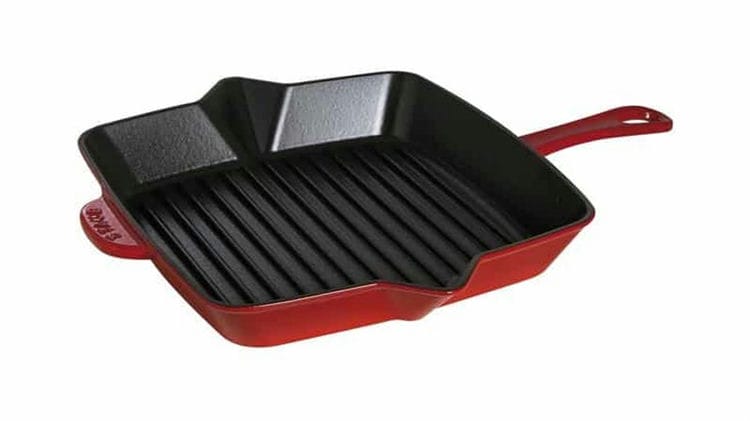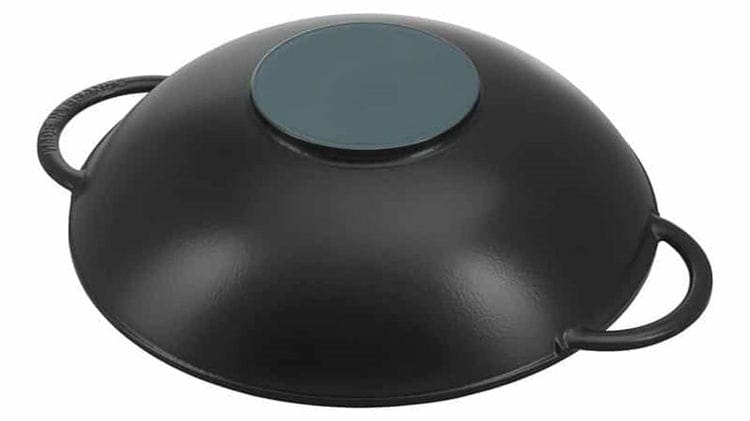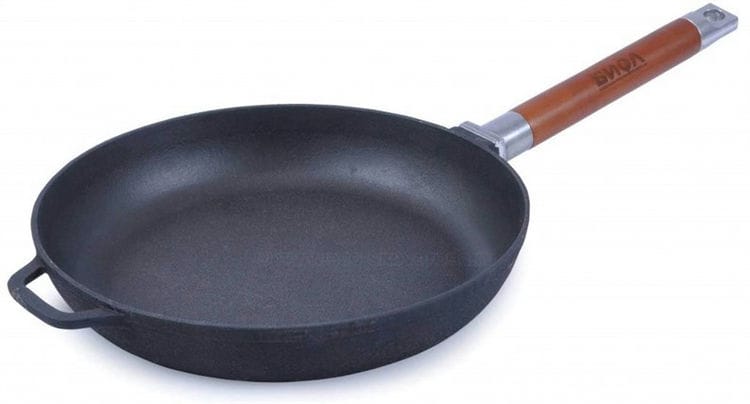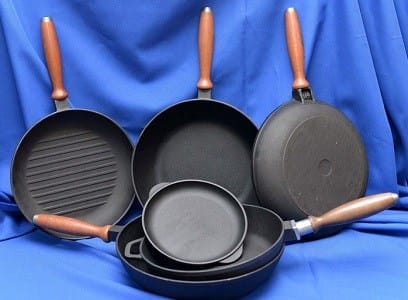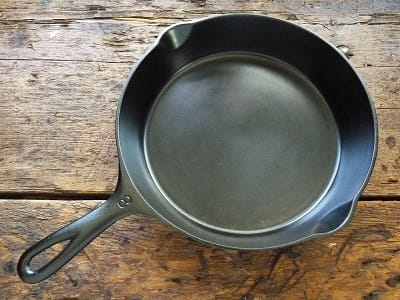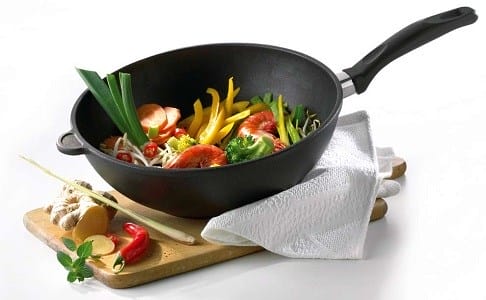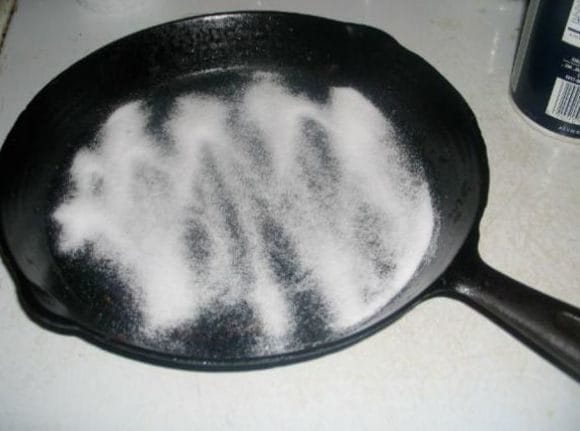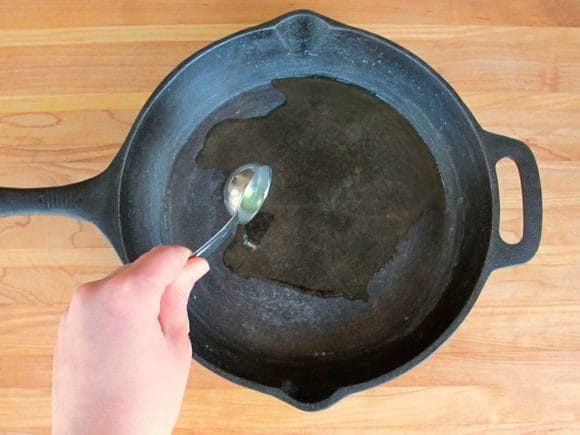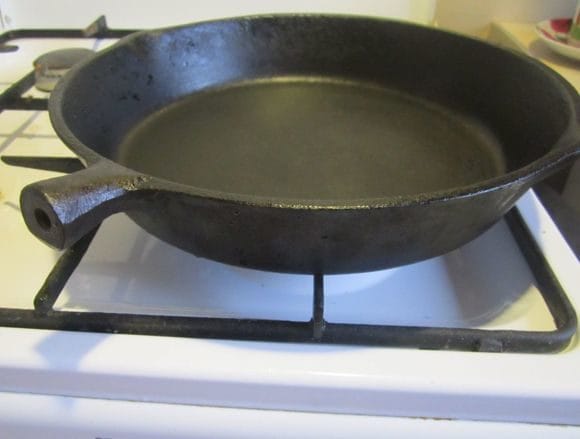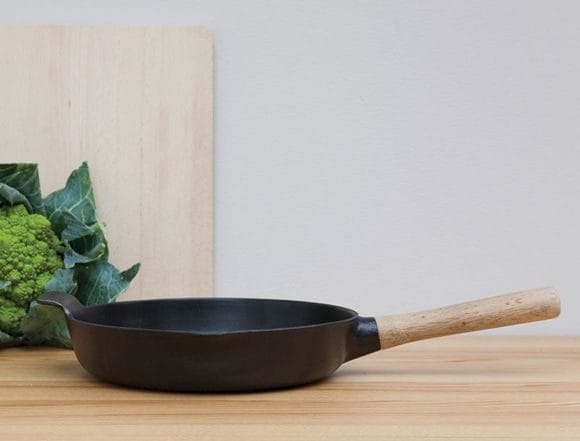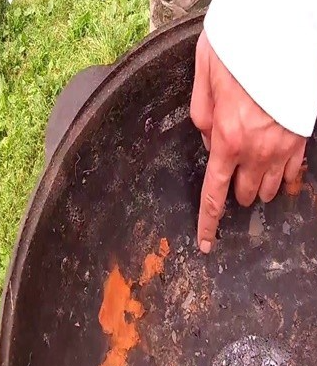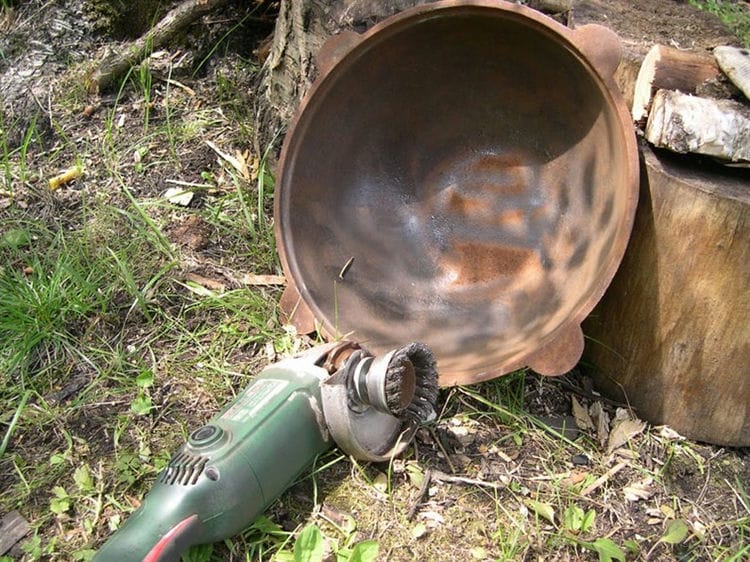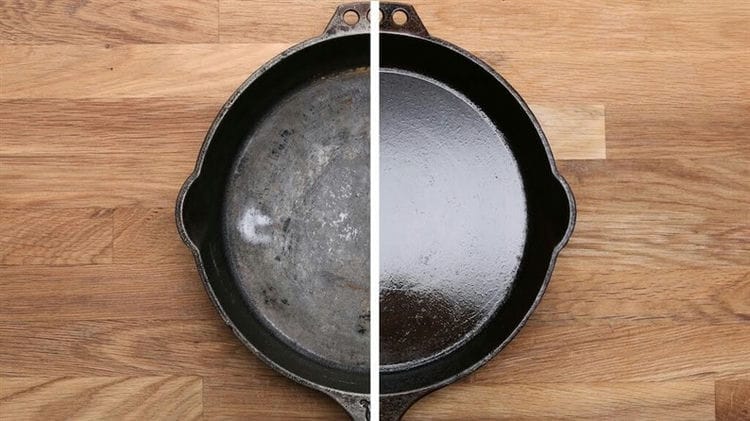Types of cast iron pans
Such pans are constantly being improved. In addition to traditional cast iron products similar to those used by our grandmothers, there are frying pans with modern coatings. The properties and characteristics of the cookware differ depending on the surface treatment.
Without cover
Simple cast iron pans are inexpensive utensils. Food in them can be mixed with a spoon, without fear of scratching the surface. The lack of a protective layer also speaks of the safety of the dishes: it does not emit harmful substances during cooking.
The appearance of such pans is not very attractive: they are black with thick walls and significant weight.
Modern uncoated cast iron products are not made according to old technologies. The basic difference in production methods is that the utensils are now being carefully processed. The result is a natural oily coating on the bottom of the item.
When the pan is heated to a high temperature, the layer of polymerized fat breaks down and forms a special substance similar to polymer. The compound penetrates into the pores of the cast iron, so nothing sticks to the dishes.
Coated
To improve the properties of cast iron pans, they are coated with special compounds. By the type of coating, they are enameled and with non-stick properties.
The first type is resistant to corrosion and harsh cleaning agents. These utensils can be washed in the dishwasher, they keep food longer. The pans are enamelled in several layers, resulting in an attractive white or cream color. Disadvantages of dishes – food burns in it, the surface is not resistant to chips and cracks.
A nonstick coating is a chemical spray that prevents food from burning. The main disadvantage of such pans is their short service life. Such dishes can hardly be called safe: during frying, the sprayed layer gives off the harmful substances contained in it to the food.
Varieties of cast iron pans
They purchase a cast-iron frying pan solely based on its purpose. There are universal models, but experienced chefs recommend having several types in the kitchen for specific dishes.
Classic
The product is round in shape, with high sides, a cover and a handle. Classic pans are used for frying and stewing. Can be cooked in the oven or overhead.
Domestic manufacturers strictly maintain the thickness of the products. Therefore, they are heavy in weight.
Cast iron grill pan
Suitable for cooking meat, fish, vegetables. The dishes are juicy, aromatic and healthy.
A distinctive feature of the grill pan is the ribbed bottom. This feature allows the juice and fat that are released during frying to drain into the grooves. High ribs keep food at a great distance from the frying surface. Therefore, the beneficial properties of the products are preserved.
Cast iron grill pans are round, square and oval in shape. The choice of size depends on the stove on which the cooking is taking place. For gas, round grill pans with a diameter of 30-45 cm are more suitable.In the instructions for induction cookers, it is recommended to select dishes for the diameter of the burners.
Advice. It is better not to put cast iron pans on the glass-ceramic hob.
When choosing grill pans, chefs recommend paying attention to the height of the walls. Deep frying pans fry food better.
An important part of the grill pan is its handle. It should be made of heat-resistant plastic, wood or silicone. Heavy models are often made with a one-piece handle. Modern models with removable handles are easy to use. When stored, they are simply removed and take up little space.
Pancake maker
The cast-iron pancake pan is time-tested, and modern Teflon pancake makers do not compete with it.
Thanks to the uniform heating of the entire surface, it is convenient to fry pancakes in a cast-iron pan. Low sides make them easy to flip.
Cast iron pancake pans are suitable for all types of stoves.
Stewpan
In modern words – two in one. This is both a frying pan and a saucepan. Suitable for cooking any kind of food. Thanks to the thick bottom and sides, the food heats up and cooks evenly. This is a cookware with a lid that maintains and controls the liquid level.
Wok
Cast iron pan with Asian roots. China is considered the homeland. In appearance, wok pans differ from our compatriots: they are round in shape, large in size, have a small flat bottom and high walls that expand at the top. They recognize the WOK by two small lugs and a convex lid. The kit sometimes includes a special grid for easy stirring.
Advantages and disadvantages of cast iron cookware
The choice and purchase of a cast-iron frying pan should take place only after studying all the characteristics of the dishes presented. The positive aspects include the following factors:
Standard round size cast iron cookware
- Cast iron types of pans make it possible to quickly cook a variety of dishes – the surface heats up quickly and keeps heat evenly, which saves energy and gas.
- The presented material does not produce toxic components during heating.
- Cast iron cookware is universal – it can be used for cooking on any gas and electric surface.
- Cookware is distinguished by the presence of non-stick properties.
- Cast iron is durable.
- The material does not deform with prolonged heating.
- The original appearance is preserved for a long time.
The disadvantages of cast iron cookware include:
- Cast-iron dishes will have to be carefully looked after – such a pan cannot be washed with cleaning agents, and also left wet to avoid the formation of rust.
- These pans are heavy, so you only need to use them in the kitchen for certain dishes.
- The presented kind of models have large diameters, so it is difficult for an inexperienced hostess to handle them.
- Do not store cooked food in a cast iron skillet.
Choose your dishes carefully. It is better to hold the pan in your hands for a long time. This will help determine the choice if hand movements are required in cooking.
Preparation and operation rules
All of these tips only apply to uncoated pans. Cookware with non-stick dusting and enamelled dishes must not be subjected to aggressive cleaning. Follow the recommendations for the care of the coating.
Preparing for the first use
Most of the new frying pans sold in stores are already prepared for use and do not need to be ignited. The preparation is carried out at the factory by placing cast-iron dishes in hot ovens, having previously greased them with oil. The manufacturer informs about this on the packaging or in the instructions.
As a rule, it is enough to wash new dishes, then heat an empty pan on the stove, grease with a thin layer of oil and heat well again. If you bought a frying pan that has no coating at all, you must definitely prepare it for the first use – ignite it.
The procedure closes the pores, making the surface non-stick. In the process of heating with oil, a thin, smooth film forms on the cast iron. We considered all methods in detail here, we will not repeat ourselves.
Operating tips
The rules for using a cast iron pan depend on the type of coating. If it is not there, then you can safely use metal shovels and tongs. It is better to wash cast iron with special or not very aggressive detergents, without overusing metal sponges.
The most important thing is that you should not leave the dishes damp ; this makes the cast-iron frying pan rusty. Always wipe the inside and outside thoroughly with a soft or microfiber cloth. You can even lubricate with a thin layer of oil, rubbing it into the bottom and walls.
If rust appears, it must be removed immediately to prevent spreading. There are special rust removers. If there are none, it will have to be cleaned mechanically. After processing, be sure to perform the same manipulations as when preparing new dishes.
We hope our instructions have helped you figure out which cast-iron pan is better and choose the right one for you. And if you have something to add, write your useful tips and advice to other readers in the comments.
Processing new cast iron cookware
In order to prolong the life of the frying pan, it is calcined before the first use and after each washing with aggressive agents. This procedure improves the non-stick properties of the cookware.
How to ignite
There are several ways to ignite a frying pan: it is either baked in the oven or kept on fire.
Algorithm of actions for the oven:
- Wash new utensils with hot soapy water and a brush.
- Dry the cast iron product.
- Preheat oven to + 350 ° C.
- Rub the dishes thoroughly and evenly with sunflower oil using a paper towel.
- Place the skillet in the oven.
- Wait until the oil has completely evaporated (1–1.5 hours) and remove the product.
- Cool down.
- Repeat all manipulations, starting with oiling.
When heated, oil penetrates into the iron and creates an additional non-stick layer on the surface. This layer will become thinner with each cooking.
Important! When igniting in the oven, the pan is placed upside down.
Carrying out the procedure on fire, use salt. It is poured onto the bottom of the dish in an even layer of 1–1.5 cm. The pan is left on the fire for several minutes until you hear a crackle. Then oil is added to the salt, left for another half hour. After they cool. With this method, a lot of smoke is generated – you will have to ventilate the room.
Another method of roasting involves using an open fire and then baking in the oven. A pan with salt, as in the second case, is kept on fire until you hear a crackling sound. Then the salt is poured. The dishes are cooled, wiped off with a paper towel and evenly treated with oil. Then it is calcined in the oven for 2 hours.
How to choose a cast iron pan
Dishes are an essential aspect of human life. The right choice is very important here, because the taste and benefits of cooked food depend on the quality of the utensils.
Purpose
It is necessary to take into account what the dishes are bought for and what they will cook in them. There are several types of pans, depending on the purpose:
- For pancakes – their weight and thickness are the smallest. They have a flat bottom, small sides and a long handle.
- Grill – this type of corrugated bottom, as a rule, comes with a cover of a smaller diameter for pressing down (mainly with a weighting agent). There is no need to use oil during cooking, foods processed in this way are much healthier.
- Normal – suitable for sautéing, frying, stewing dishes. Most often round, with an oblong handle, the size and height of the walls are different.
- Stewpan – Combines a frying pan and a saucepan. Almost any dish can be cooked in such dishes. The thick sides and bottom allow the food to be heated evenly. A tight-fitting lid helps control and maintain fluid levels.
- Wok – this type of frying pans is considered Chinese, where they take their roots. Round, large, with a small flat bottom, high sides sharply expand upward. There are usually two handles, they are small, in the form of “ears”. The lid is convex, round. Sometimes a grid is included for convenient stirring of cooked food.
Some dishes can be cooked in any utensil that is not just for them. When buying a cast iron frying pan, it is worth considering the features of this material and your personal wishes.
Diameter
The size and shape of the pans depends entirely on the purpose. The inner section is calculated along the top contour, not along the bottom. The smallest products are pancake ones, they start from 16 cm, and the largest are wok-pans, their sizes can reach 50 cm.
Professional cookware is different from home cookware. The diameter of products for restaurants and other establishments often exceeds 50 cm, and there are cases when it can reach 1 m or more.
Coating
Usually, cast iron cookware is made in the classic version. The material has enough advantages and does not need additional improvements. But enamel or non-stick pans are also common on the market.
There are pros and cons to both types. Enameled dishes will not rust if there are no chips, food can be stored in it for a long time. But in the presence of damage, the product easily corrodes, and cracks begin to appear from temperature changes. Non-stick pans are great at preventing food from burning, but they are short-lived and difficult to maintain.
When choosing coated cast iron cookware, it is necessary to weigh the feasibility of such an acquisition. The cost of such options is rarely offset by the merits.
Wall and bottom thickness
Cast iron pans are quite thick, because of this they have a lot of weight. A high-quality product has a wall thickness of 0.5 cm and a bottom of 1 cm. An exception is a pancake pan – 0.3-0.5 and 1 cm, respectively.
Modern manufacturers often save money, so on the market it is rare to find specimens that meet all the requirements.
Price
The variety of manufacturers, forms, purposes and quality of goods creates a large fluctuation in value. You can find cast iron pans from 1000 rubles, but the price of high-quality foreign options can reach 15,000.
The larger and thicker the dishes, the more expensive they are when compared within the same manufacturer. The exception is pancake baking products, they are usually thinner and smaller than others, but their cost is higher.
The main methods of roasting a frying pan
Previously, cast iron utensils were burned on a fire or kept in a hot oven. After that, the cast iron was lowered into cold water or thrown into the snow. Thus, the dishes could not only be cleaned, but also tempered. Now the initial processing procedure is carried out on a stove or in an oven. This can be done in several ways. Each housewife chooses it independently. They are all equally effective. Smoke is generated during the procedure, so it is important to provide for an air flow. This is the main rule for firing. It is best to turn on the hood and leave the kitchen for a while. With poor ventilation of the kitchen, it is better to refuse this hardening method.
Calcining with salt
The traditional and simple recipe has come from ancient times. Salt is a good adsorbent; it absorbs all oil residues. The melting point of the salt is about 800 degrees, it is higher than the melting point of cast iron (the alloy melts at a temperature of 680 degrees). Salt retains heat for a long time, it is an excellent thermal accumulator. But you need to be very careful when handling hot salt. Pour it out of the vessel only after cooling down. If you pour it into a bucket with a slide, the polyethylene will immediately melt, it may flare up. Paper, cotton fabric will begin to smolder. It is dangerous to pour hot salt into cold water, there is a high probability of burns. It is left in a pan until it cools completely. It is better to use a coarsely ground product.
The “salty roasting” procedure itself is simple: a layer of at least 1–2 cm is poured onto the bottom, depending on the height of the vessel. A frying pan with salt is kept on fire for at least half an hour.
Roasting the pan using oil
This method is used not only when processing a new frying pan, but also during operation, when the food begins to burn and the dish gets an unpleasant odor. Preventive firing is carried out once or twice a year.
Igniting a cast iron skillet using oil.
The main stages of the process:
- The washed dish is put on fire, heated until smoke appears;
- Remove, wipe well with paper napkins, grease with a thin layer of fat or oil;
- Put it on the burner again, heat it until the oil begins to evaporate;
- Again, remove the burnt layer of oil with a napkin;
- The procedure is repeated up to 5 times. After the last heating, the dish is washed well and dried. Preparing cast iron cookware in this way is time-consuming, but most effective. A shiny layer should be visible on the pan, visually creating the feeling that the pan is covered with a layer of varnish. It acts as a non-stick coating. The pan is ready for long-term use.
It must be remembered that the protective oily layer is destroyed under the influence of aggressive detergents containing acids or alkalis. A prepared cast iron pan requires special care.
Annealing on the stove
You can burn a cast-iron pot on a hob or stove of any kind. The stove-top method is ideal for pans with non-removable wood, Teflon or silicone handles. The processing process consists in heating the cast iron until the color changes: the alloy will begin to turn gray. This indicates the burnout of the lubricant used in the manufacture. The hot pan is immersed in a large container of cold water.
The method of calcining a cast iron pan on the stove.
It is important to remember that it is dangerous to put a preheated pan under the stream: the generated steam will rush upward in a column. There is a high probability of damage to furniture, lighting fixtures located above the sink.
As soon as the pan cools down, wipe it, put it on the fire again, fill it with vegetable oil to a layer thickness of up to 2 cm. Put it on a slow fire, heat it up for half an hour. If the oil begins to evaporate earlier, the procedure will be shortened. After switching off the hotplate, the oil is made up until it cools completely. After that, it must be drained. Used oil is disposed of, its composition is close to drying oil, contains impurities of lubricants. The dishes are washed, wiped, put away for storage.
Roasting the pan in the oven
It is convenient to burn cast iron products without a handle in the oven. To do this, get everything out of it. Before calcining the vessel, be sure to rinse it thoroughly. After drying, the dish is wiped from the inside and outside with a cotton cloth soaked in vegetable oil. Synthetics are not good. The cloth should be large, completely cover the bottom. The pan is turned upside down, covered with an oiled cloth, in this form it is sent to an oven heated to 180 degrees. The heating holding time is from 20 to 30 minutes, depending on the thickness of the pan. When the oven is turned off, do not open it for an hour. Then check if the pan is warm. It is left in the oven until it cools completely. This method is not accompanied by a large volume of smoke.
Do not forget to place a baking sheet at the bottom of the oven or cover the surface with foil so that the oil that rolls off the fabric does not get onto an open flame or heating elements.
On an open fire
If the new cast-iron cookware does not mean a frying pan, but a cauldron or a rooster, then perhaps it will be more convenient to ignite them over an open fire. For a frying pan, you can also use this option. Its main advantage is that the smoke dissolves immediately into the air, without filling the entire apartment.
The principle of action is as follows:
- rinse and dry the dishes;
- set on an open fire and wait for the color of cast iron to change from black to gray;
- pour cold water or overturn in a snowdrift – this should be done carefully, as there will be a lot of steam;
- wipe dry;
- grease with oil and return to fire;
- ignite, rinse, dry;
- repeat twice.
This option is costly in terms of time and effort, but you don’t have to get rid of the burning smell in the kitchen. Instead of an open fire, you can also use rustic stoves, where there are holes in the heating surface.
Combining options
On the basis of the three methods presented in the article, housewives for processing pans invent their own, for example:
- A frying pan filled with salt is fired in the oven, the cooling rate slows down, the pot is kept for more than 2 hours;
- First, a cast-iron frying pan is ignited on the stove, then it is heated with oil, after draining it, salt is poured, and the pot is reheated.
Unlike Teflon or ceramic pans, cast iron pans are not limited in terms of service life.
Each housewife creates her own method by trial and error. The main thing is to achieve the right goals:
- Remove industrial grease from a cast iron pan;
- Create an oily non-stick layer.
Only in this case will it be convenient to use a fried pan. Pancakes will not clump on it, potatoes will not stick to the bottom when frying. It will be comfortable to use the dish.
In what other cases is it necessary to ignite
Calcining is required not only for a new frying pan, but also for the sake of prevention, and even getting rid of problems that have arisen on old ones.
- Carbon deposits – burnt oil – often form on a cast-iron frying pan. It is unhealthy, so you cannot cook on such a surface. In this case, calcination will just help, since it will be able to destroy the accumulated carbon deposits, after which it will be easy to wash it off. Usually, the question of how to properly burn a pan from carbon deposits is asked before cooking pancakes. Thus, the frying pan is cleared of old oil – even the first pancake will not be lumpy.
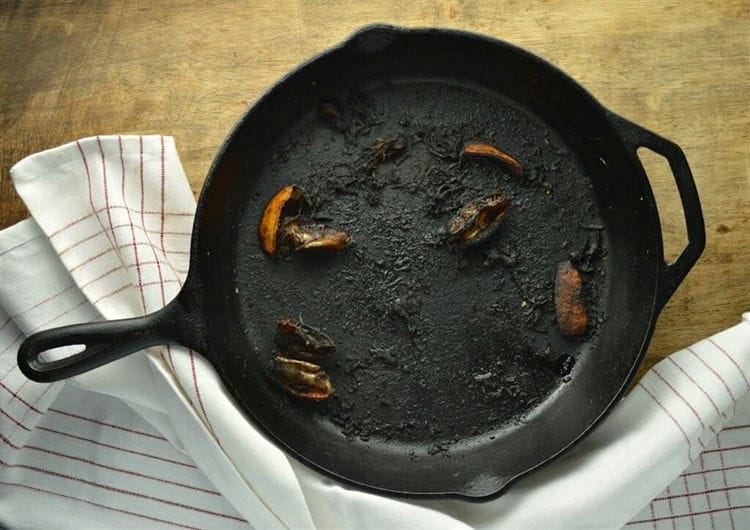
- If the cast-iron cookware has begun to rust, then it is necessary to properly process it from rust. First of all, it is necessary to clean out the damaged areas. This can be done with a special cleaner or with a simple cleaning powder. After that, they are additionally traversed with fine-grain emery paper. The cookware can then be baked to create a new protective coating to prevent future rusting.
![13 gross mistakes in cast iron pan care. How to care for a cast iron pan, useful tips]()
How to properly wash a product after cooking?
Proper care of the cast iron cauldron will help to preserve the original appearance of the product for a long time, extend its service life. It does not require special care, it is only important to adhere to some recommendations.
At home
After the initial treatment, food residues do not adhere to the walls and bottom, therefore, preliminary cleaning and soaking are not required. It is not recommended to wash cast iron dishes with a metal brush. The cauldron is freed from food debris. Fill the container with water, bring it to a boil. Then it is cooled, washed with a sponge using detergents.
In the field
In nature, you can quickly clean the cauldron from dirt. After cooking over a fire, the dishes are freed from food debris, filled to the brim with river sand. In this form, the cauldron is left to warm up on the coals until morning. Then remove the dishes from the heat, leave to cool. Remove the sand, fill the container with salt, ignite. After the salt has darkened, pour out the contents, wipe the inside with a dry cloth.
Solving common problems
Depending on the type of contamination, methods for caring for a cast-iron cauldron differ. Caring for dishes involves the following steps: cleaning, soaking, boiling. Despite the “brutal” appearance, cast iron cookware requires careful handling.
Nagar
It is forbidden to use household chemicals to clean the surface of a cast-iron cauldron from carbon deposits. Such agents destroy the structure of the oil film, the surface quickly deteriorates. Conventional detergents or folk recipes will help to cope with pollution. A mixture of salt and water cleans the container well from carbon deposits. Gruel is applied to the contaminated area, wiped with a sponge and washed off with water. Laundry soap and stationery glue will help to remove carbon deposits at home. The dishes are washed with a detergent. Lower the container into the bucket. A mixture is prepared from a grated bar of soap and 100 grams of glue. Fill the bucket with water, put it on the stove. Add the prepared mixture and dissolve in water. The contents are boiled for 2-3 hours. Clean the cauldron with a sponge, rinse with water.
Smells
If a musty smell develops, it can be removed in several ways. In the first case, you can simply ignite the cauldron with oil, the smell will disappear. You can use table salt to ignite the container.
In the second case, boiling water with vinegar helps a lot. Prepare a solution in a 1: 1 ratio of components. After this cleaning method, you will need to re-ignite the cauldron.
Rust
Moisture is the main enemy of the cast-iron cauldron, since the material contains iron. When the first signs of corrosion appear, they must be eliminated immediately, otherwise the dishes will become unusable. Small corrosion spots are removed with baking soda. The product is applied to the problem area, a drop of water is added and the area is cleaned with a sponge. Leave for 10 minutes, then repeat the procedure. Rinse the cauldron under running water.
Thick layers of rust can be removed with vinegar. It is mixed with water in a 1: 1 ratio. Place the cauldron in this solution and leave for 3 hours. Clean the problem area with a metal brush.
Why do you need resurfacing and how to carry it out
The grinding procedure will help to remove old rust stains and burnt fat embedded in the walls of the cauldron. It can be carried out using the following means:
- Special cleaning powder “Pemolux”. They treat the contaminated surface, after which they additionally pass with sandpaper or a metal sponge.
- Drill with special grinding disc. The cleaning procedure is similar to sanding the surface, only several times faster and easier. After cleaning, the cauldron must be washed and wiped dry.
- Car service. Car service specialists will quickly clean the cauldron from fat with a special grinder for metal, if it was not possible to clean the dishes with high quality on their own.
Cast iron pan care
There are several “golden” rules that will help pass a cast iron pan to the next generation in excellent condition:
- Use only mild detergents.
- Hand wash only.
- Try to remove carbon deposits at their inception using natural remedies – mustard, soda or vinegar.
- Do not use metal sponges.
- Do not leave food in cast iron dishes.
- Soak stains that are difficult to remove in hot water.
- If the grease is thick, you can boil water in a skillet for easier cleaning.
- Ensure that the dishes are stored in an oiled cloth.
- Always preheat the pan before placing food on it.
- After washing, immediately wipe the dishes with a towel, since the cast iron should not remain wet.
- Wipe the food with a paper towel to remove excess moisture.
These simple tips will help you keep the performance of your dishes at their best, so your food will be as tasty and healthy as possible.
Conclusion
A cast iron frying pan is an excellent kitchen unit that can serve for more than one decade, delighting with tasty and healthy food. But for this there is a condition – proper care of the dishes, including preparation for the first use. There are many options for such training – you can choose the one that you like the most.
Sources used and useful links on the topic: https://rem.ninja/kuhnya/posuda/uhod-za-skovorodoy-iz-chuguna.html https://rem.ninja/kuhnya/posuda/obzor-chugunnyh-skovorodok.html https://TechnoSova.ru/dlja-kuhni/skovoroda/luchshaja-chugunnaja/ https://vidy-posudy.ru/kak-vybrat-chugunnuju-skovorodu-s-uchetom-prigotavlivaemogo-bljuda-i-praktichn : https://vidy-posudy.ru/kak-vybrat-chugunnuju-skovorodu-s-uchetom-prigotavlivaemogo-bljuda-i-praktichn : //ktchn.ru/kuhonnye-prinadlezhnosti/kak-vybrat-chugunnuyu-skovorodku.html https://prof40.ru/poleznye-sovety/article_post/kak-podgotovit-chugunnuyu-skovorodu-olzhatovya-tem-kak https://remontkit.ru/poleznye-sovety/kak-podgotovit-chugunnuju-skovorodu.html https://hozzi.ru/chistka/kak-uhazhivat-za-chugunnym-kazanom https://posuda-gid.ru/ chistka / 30-kak-myt-kazan

